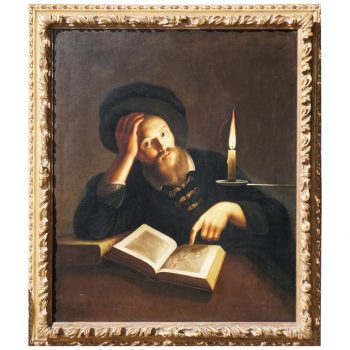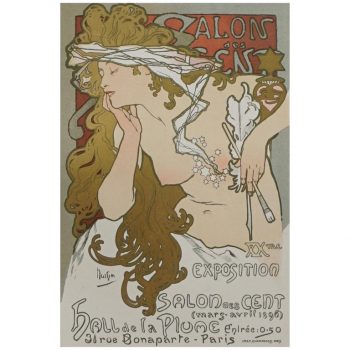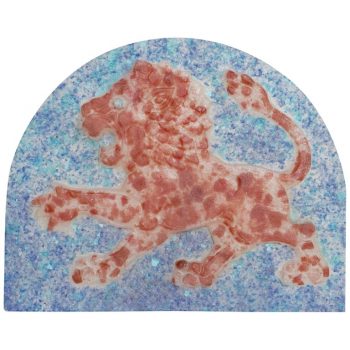Description
Emile Galle (1847 – 1904) Faience Tin Glazed Pottery Figure of A Dog.
A whimsical French bull dog dressed in a formal tail coat and political wig with signature Galle glass eyes. The coat stitched with a floral design on striped blue and white coat. These Galle pottery figures are almost never signed as this one it. They are also almost always damaged and repaired unlike this one. A great addition to the family and a great investment.
Condition: Excellent with only one small chip on left ear. No breaks, cracks or repairs.
Measures: Height: 14.25 Inches, Width: 13.25 Inches, Depth: 6.5 Inches
Émile Gallé (8 May 1846 in Nancy – 23 September 1904 in Nancy) was a French artist and designer who worked in glass, and is considered to be one of the major innovators in the French Art Nouveau movement. He was noted for his designs of Art Nouveau glass art and Art Nouveau furniture, and was a founder of the École de Nancy or Nancy School, a movement of design in the city of Nancy, France. Gallé born on 4 March 1846 in the city of Nancy, France. His father, Charles Gallé, was a merchant of glassware and ceramics who had settled in Nancy in 1844, and his father-in-law owned a factory in Nancy which manufactured mirrors. His father took over the direction of his mother’s family business, and began to manufacture glassware with a floral design. He also took over a struggling faience factory and began manufacturing new products. The young Gallé studied philosophy and natural science at the Lycée Imperial in Nancy. At the age of sixteen he went to work for the family business as an assistant to his father, making floral designs and emblems for both faience and glass. In his spare time he became an accomplished botanist, studying with D.A. Godron, the director of the Botanical Gardens of Nancy and author of the leading textbooks on French flora. He collected plants from the region and from as far away as Italy and Switzerland. He also took courses in painting and drawing, and made numerous drawings of plants, flowers, animals and insects, which became subjects of decoration. At the age of sixteen he finished the Lycée in Nancy and went to Weimar in Germany from 1862–1866 to continue his studies in philosophy, botany, sculpture and drawing. In 1866, to prepare himself to inherit the family business, he went to work as an apprentice at the glass factory of Burgun and Schwerer in Meisenthal, and made a serious study of the chemistry of glass production. Some of his early glass and faience works for the family factory at Saint-Clémont were displayed at the 1867 Paris Universal Exposition. In early 1870 he designed a complete set of dishware with a rustic animal designs for the family enterprise. During this time he became acquainted with the painter, sculptor and engraver Victor Prouvé, an artist of the romantic “troubadour” style, who became his future collaborator in the Nancy School. He enlisted for military service in the Franco-Prussian War in 1870, then was demobilised after the disastrous French defeat in 1871 and the French loss to Germany of much of the province of Lorraine, including Meisenthal where he had done his apprenticeship. Thereafter the Cross of Lorraine, the patriotic symbol of the region, became part of his signature on many of his works of art. After his demobilization Gallé went to London, where he represented his father at an exhibition of the arts of France, then to Paris, where he remained for several months, visiting the Louvre and Cluny Museum, studying examples of ancient Egyptian art, Roman glassware and ceramics, and especially early Islamic enamelled glass, a technique which influenced his own later work. After further travel to Switzerland and Italy, he returned to Nancy and established his own workshop at the glass factory. His father Charles continued as head of the company, but Émile gradually took charge of the design and production. In 1873 he took up residence in La Garenne (“the rabbit warren”), the three-story neoclassical house built by his father and surrounded by gardens. In 1874 the elder Gallé turned the family business, the Maison Gallé-Reinemer, over to Émile. The following year Émile married Henriette Grimm, and after years of traveling, settled permanently in Nancy. He regrouped and reorganized the divisions of faience and glass manufacture, and in 1883 built new and larger workshops for glass and faience manufacture also for making furniture. By 1889 he had over three hundred employees. His own office and studio was in the center of the complex. He trained the designers himself, and sent them water colors of floral designs he made in the gardens of his residence. Gallé ordered his designers to use only real flowers and plants as their models, though they could take some liberties in the final design. He wrote in 1889, “it is necessary to have a pronounced bias in favour of models taken from flora and fauna, while giving them free expression.” Gallé continued to expand his activities. In 1885 he opened his first shop in Paris at 12 rue Richter, followed by other shops in Frankfurt-am-Maine and London. He also took part on a grand scale in international expositions; beginning with the 1878 Paris Universal Exposition, where his pavilion was thirty meters long; the 1893 World’s Columbian Exposition in Chicago; and especially the 1900 Paris Universal Exposition, which was the summit of his fame. His work at the Exposition was rewarded with two Grand Prizes, a gold medal, and the title of a commander in the Legion of Honor.





